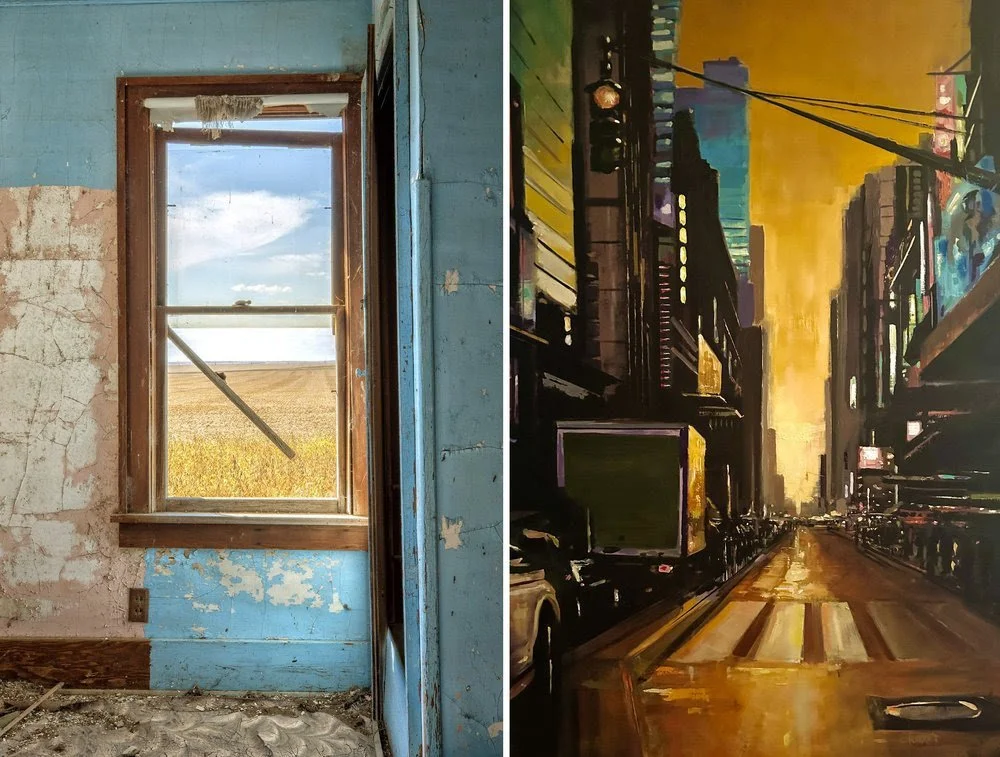
Travel, time and place
Left ,“Interior V ‘‘ (photograph on aluminum), by Rebecca Skinner. Right, “W. 42nd St.’’ (oil on panel), by Chris Plunkett, in the group show “Travelling,’’ at Fountain Street Fine Art, Boston.
The gallery says:
“‘Travelling’ suggests a sojourn to a destination in some form or another, and the concept of ‘place’ is examined along multiple vectors by this group of artists. Rebecca Skinner’s interior/exterior photographs of abandoned places contain a textural richness revealing a morphological study not merely of paint, brick, and wood, but also the chronological layers of story. The vibrant cityscapes that fluidly leap from the brush of Chris Plunkett….{T}he intensity of his palette turns recognizable metropolitan scenes into urban spectacles out of fondly remembered dreams.’’
Chris Powell: Mocking the law and getting little integration
In Constitution Plaza in downtown Hartford
MANCHESTER, Conn.
What has Connecticut gotten for the 33 years of litigation in the Hartford school-integration case of Sheff v. O'Neill, which purportedly ended last week with a settlement between the plaintiffs and state government?
The first result of the Sheff business is a mockery of state constitutional law and the courts themselves.
The state Supreme Court's 4-3 decision in the Sheff case in 1996 proclaimed that every public school student in the state -- not just students in Hartford -- has a state constitutional right to a racially integrated education. That conclusion was not only dubious law -- it was torn to shreds by the brilliant dissent of Justice David M. Borden -- but also impossible to achieve as a practical matter, since it would have required the assignment to school by their race of tens of thousands of students across the state, which federal courts would have forbidden as federally unconstitutional.
Even the Sheff plaintiffs knew that comprehensive racial integration was impossible and they never pressed for it. They were concerned only about Hartford, where the school population consisted overwhelmingly of impoverished, fatherless, and neglected minority children whose educational performance was miserable.
While the state Supreme Court's proclamation of a constitutional right stands, 26 years later it is being violated in most towns and there is and will be no effort to enforce it.
So much for constitutional law in Connecticut.
The second result of the Sheff case is the continued de-facto racial segregation of the Hartford schools themselves.
Because of the state's creation of Hartford-area "magnet" or regional schools that draw both city and suburban students, the city's schools are less segregated than they were. But still about 60 percent of Hartford students are enrolled in schools considered segregated. Similarly, most suburban and rural schools in the state remain segregated too, overwhelmingly white.
Connecticut's huge and long-lamented racial-achievement gap between white and minority students endures in both the Hartford area and the state generally. And while the integration produced by the regional schools may have good results over the long term as students gain more diverse friends and acquaintances, the regional schools have had a negative effect as well.
That is, the regional schools drain Hartford's neighborhood schools of their more-parented students, leaving the neighborhood schools with even more disadvantaged populations. While the regional schools are advocated for mixing disadvantaged minority city students with middle-class suburban students who may provide better examples academically, this comes at the expense of neighborhood schools that lose their own better examples.
Even so, the Sheff settlement has state government promising still more regional schools and school-choice programs -- more openings for city students in suburban schools -- until there is room for every Hartford student who wants to escape a neighborhood school.
Maybe then it will be possible to acknowledge the underlying problem officially -- the most neglected kids, the core of the unassimilable urban poverty that long has driven the white flight to the suburbs and now is driving the minority middle class out of the cities as well.
In recent years state government is estimated to have spent hundreds of millions of dollars on regional schools in the Hartford area and the complicated transportation arrangements they require. The integration this has produced is so small as to invite questions as to whether other approaches might be more productive and cheaper.
Poverty may be a virtue in religious orders but it is a curse in society, since the poor don't pull their own weight. So suburban fear of housing for the poor is fair, and such housing is difficult to develop in the suburbs even as state law purports to require it in the towns with the most exclusive zoning.
So maybe once regional schools and choice programs have drained Hartford and the state's other troubled cities of their most-parented students a decade or two from now, government in Connecticut will be compelled to examine the neglected children who remain and to inquire into what has made them so poor. If it is honest, such an inquiry will begin with government itself.
Chris Powell is a columnist for the Journal Inquirer, in Manchester.
Winter looks better now
“Winter Sunrise Over Summer Street” (Boston) (oil on wood panel), by Chris Plunkett, in the group show “2020: Sharp Focus,’’ at Fountain Street Fine Art through Sept. 27.
See:
https://www.fsfaboston.com/
and
https://www.chrisplunkettstudios.com/carousel.php?galleryID=208528



